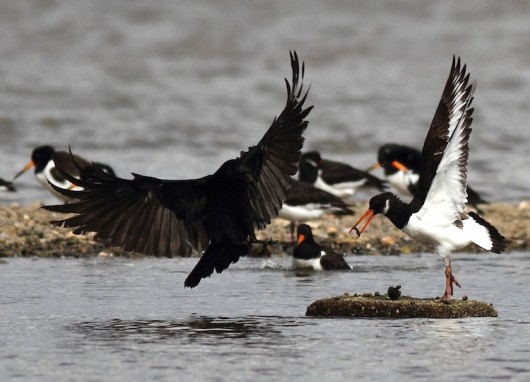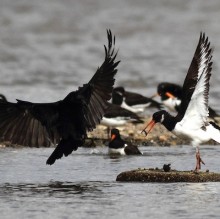Effects of kleptoparasitism on feeding waders
LINKED PAPER
The effect of kleptoparasite and host numbers on the risk of food-stealing in an avian assemblage.
Wood, K.A., Stillman, R.A. & Goss-Custard, J.D. 2015. Journal of Avian Biology. DOI: 10.1111/jav.00705
Combining field observations and statistical modelling, our study examines the potential influence of key extrinsic factors on the risk of feeding Oystercatchers being robbed by kleptoparasites. We provide evidence that bird numbers influence the risk of successful kleptoparasitism within avian assemblages.
The theft of food items from one individual by another, termed kleptoparasitism, has been observed in a wide range of avian species (Amat, 1990; Brockman & Barnard, 1979). Food-stealing behaviours can have important consequences for both the kleptoparasites and their hosts, in terms of individual fitness and population sizes. As an example, Phillips et al. (1996) reported that over a 21 year period inter-annual fluctuations in the population size of Arctic Terns Sterna paradisaea around the coast of Shetland (UK) were closely matched by changes in the population size of their main kleptoparasite species, the Artic Skua Stercorarius parasiticus. In order to understand interactions between kleptoparasites and their hosts, researchers need to quantify the factors which influence the risk of kleptoparasitism. Improving our knowledge of how kleptoparasitism varies in space and time, and with biotic and abiotic factors, will help ornithologists understand when and where the impacts of kleptoparasitism on individual fitness, population sizes, trophic interactions, and food webs will occur.

Wader populations in intertidal areas, that feed on large-bodied invertebrates such as shellfish, represent a useful study system in which food-stealing behaviour can be studied. The relatively simple intertidal habitat structure, unobscured views, and large, distinct food items ensure that feeding behaviours and interactions can be observed clearly, even from a distance (Fig. 1). In temperate European intertidal areas, Eurasian Oystercatchers Haematopus ostralegus feed primarily on bivalve molluscs such as Mussels and Cockles (Goss-Custard, 2014). However, feeding oystercatchers are vulnerable to attacks by kleptoparasitic species such as Carrion Crows Corvus corone and Herring Gulls Larus argentatus (Fig. 2). We know from previous research that Crows and Gulls can open mussels themselves (e.g. Whiteley et al., 1990; Norris et al., 2000), but kleptoparasitism offers a way of avoiding some of the energetic costs associated with finding and opening molluscs. In a recent study we combined foraging observations of overwintering Oystercatchers and their kleptoparasites (Carrion Crows and Herring Gulls) on the Exe Estuary (south Devon, UK) with statistical modelling to identify the factors that influence the likelihood of successful food stealing behaviour occurring. Over the 2013/14 winter (November to March) we collected almost 1000 observations of Oystercatchers feeding on Mussels, recording the outcome (i.e. whether the oystercatcher successfully swallowed the Mussel, or whether the Oystercatcher was robbed by a kleptoparasite). For each observation we also recorded a number of predictor variables: the numbers of kleptoparasites and hosts on the mussel bed, stage of the tidal cycle, and month. We used an information theoretic approach to compare multiple logistic regression models of kleptoparasitism risk.

Our foraging observations showed the risk of kleptoparasitism was variable over time, but did not vary consistently between November and March. We found that the risk of food-stealing was lowest in February (10.8 %) and highest in December (36.3 %). Across the entire 2013/14 winter, we observed that 16.4 % of oystercatcher foraging attempts ended in successful kleptoparasitism. Our study suggests that kleptoparasitism risk for Oystercatchers from Crows and Gulls is substantially greater than during previous research carried out in the 1979-1980 winter. During this earlier study, Goss-Custard et al. (1982) reported that Oystercatchers would have just 3 % of Mussels stolen by Crows, whilst kleptoparasitism by Herring Gulls was not observed. Further research is now needed to understand the costs of these higher levels of kleptoparasitism on overwintering Oystercatcher populations, as well as the potential benefits to Crows and Gulls.
By comparing our logistic regression models we found that the outcome of host foraging attempts varied with the number of kleptoparasites per host within the foraging patch for two out of five individual months, and for all months grouped together. Successful kleptoparasitism was more likely to occur when the total number of all kleptoparasites per host was greater. Across the entire winter study period, oystercatcher foraging attempts that resulted in kleptoparasitism were associated with a mean number of kleptoparasites per host that was more than double that for foraging attempts that ended in the oystercatcher successfully consuming the mussel. Conversely, the stage of the tidal cycle within the estuary did not affect the outcome of oystercatcher foraging attempts.
Our study provides evidence that the relative numbers of kleptoparasites and hosts influence the risk of kleptoparasitism within avian assemblages. The results of this study will allow us to incorporate more realistic estimates of kleptoparasitism risk into ecological models of wader foraging which are used to inform the conservation and management of wader populations in coastal habitats (e.g. Stillman & Goss-Custard, 2010; Wood et al., 2015).
References and/or further reading
Amat, J.A. 1990. Food usurpation by waterfowl and waders. Wildfowl 41: 107-116. View.
Brockman, H.J. & Barnard, C.J. 1979. Kleptoparasitism in birds. Animal Behaviour 27: 487-514. View.
Goss-Custard, J.D. 2014. Birds and people: resolving the conflict on estuaries. Kindle Direct Publishing. View.
Goss-Custard, J.D., Durell, S.E.A. Le V. Dit & Ens, B.J. 1982. Individual differences in aggressiveness and food stealing among wintering oystercatchers, Haematopus ostralegus L. Animal Behaviour 30: 917-928. View.
Norris, K., Freeman, A. & Vincent, J.F.V. 2000. The economics of getting high: decisions made by common gulls dropping cockles to open them. Behaviour 137: 783-807. View.
Phillips, R.A., Caldow, R.W.G. & Furness, R.W. 1996. The influence of food availability on the breeding effort and reproductive success of Artic skuas Stercorarius parasiticus. Ibis 138: 410-419. View.
Stillman, R.A. & Goss-Custard, J.D. 2010. Individual-based ecology of coastal birds. Biological Reviews 85: 413–434. View.
Whiteley, J.D., Pritchard, J.S. & Slater, P.J.B. 1990. Strategies of mussel dropping by carrion crows Corvus c. corone. Bird Study 37: 12-17. View.
Wood, K.A., Stillman, R.A. & Goss-Custard, J.D. 2015. Co-creation of individual-based models by practitioners and modellers to inform environmental decision-making. Journal of Applied Ecology. DOI: 10.1111/1365-2664.12419. View.
Wood, K.A., Stillman, R.A. & Goss-Custard, J.D. 2015. The effect of kleptoparasite and host numbers on the risk of food-stealing in an avian assemblage. Journal of Avian Biology. DOI: 10.1111/jav.00705. View.
If you want to write about your research in #theBOUblog, then please see here.




